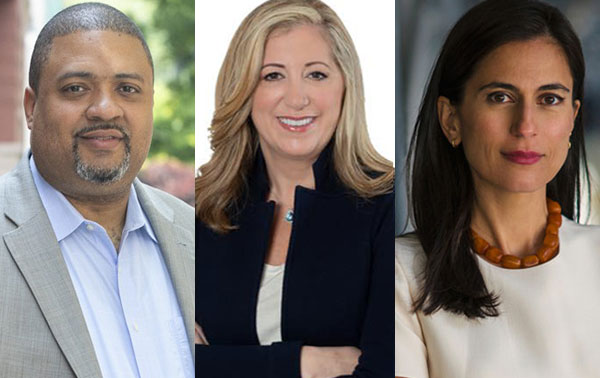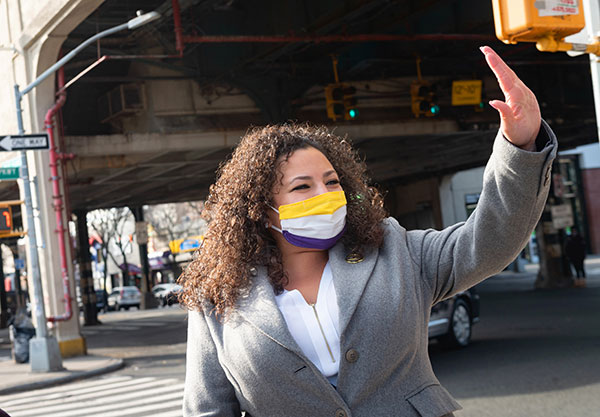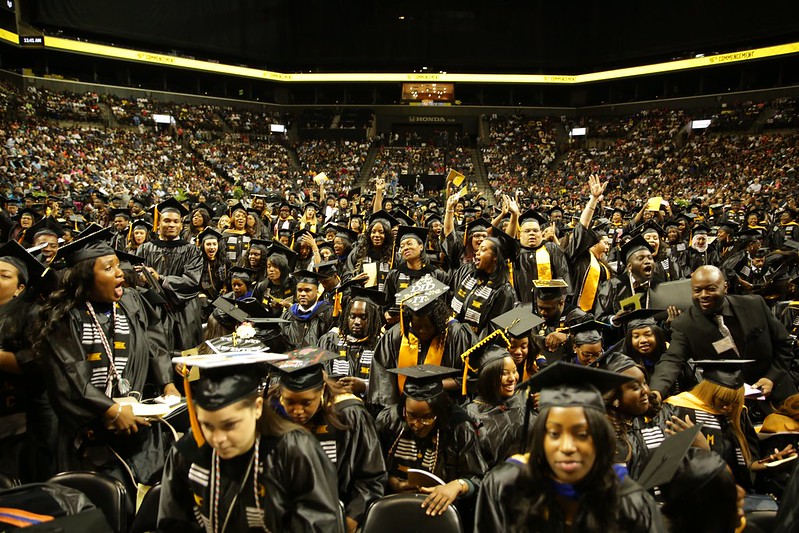The Manhattan District Attorney Sexual Assault Survivors Deserve

(l-r) Alvin Bragg, Diana Florence & Tali Farhadian Weinstein
President Biden is right that Governor Cuomo could face criminal charges for his alleged sexual harassment of current and former aides. Forcibly kissing Lindsey Boylan in the Governor’s Manhattan office alone could trigger a probe from the Manhattan District Attorney’s office. Still, sexual assault survivors like me have no faith in that office’s ability to undertake such a delicate investigation. Manhattan DA Cy Vance continually backs away from cases involving powerful offenders, including Donald Trump eight years ago.
In just three months, voters have an opportunity to bring new leadership to the Manhattan District Attorney’s Office when Democrats choose from a field of candidates, and Vance will not be on the ballot. The current DA has repeatedly been accused of failing survivors of sexual violence despite claiming to be pro-gender justice. Survivors frequently share their experiences of being dissuaded, disbelieved, or discarded by the District Attorney’s office for not having enough evidence, for not being the “perfect victim,” or for not wanting to put themselves at greater risk. It is time for this to end.
The stakes are high in this election with so many criminal justice issues in need of reform. Most of the Democratic candidates have issued sex crimes policy platforms and agree that sexual violence is an issue affecting a significant proportion of voting residents in their lifetime. Yet, the candidates’ approaches to adjudicating sex crimes has been largely missing from the public dialogue surrounding the race.
Reform the Sex Crimes Unit, an advocacy group and campaign I started to bring change to the Manhattan District Attorney’s Office, issued a questionnaire specifically focused on each candidate's respective approach to fighting gender-based violence. An anonymous panel of nearly 20 survivors, advocates, scholars, victim and defense attorneys, and former prosecutors evaluated the responses. The goal was to identify candidates whose vision for combatting sexual violence is: comprehensive and representative of an understanding of trauma; committed to hearing from and serving the community in need; specific, transparent, and measurable; inspirational and forward thinking.
The panel concluded that three of the eight Democratic candidates — Tali Farhadian Weinstein, Alvin Bragg, and Diana Florence — centered survivors in these ways and would be serious, creative, and kind leaders. Some key ideas stood out as must-dos for whoever wins the position and becomes Manhattan District Attorney in January.
Have the sex crimes team report directly to the District Attorney and ensure they are well staffed. Farhadian Weinstein wrote, “Given the time-sensitive nature of these cases, this Bureau is likely to be the most heavily staffed in the office. The structure will include five central roles: prosecutors, in-house investigators, experts, victim advocates, and toxicologists.” Staff need a nuanced understanding of the different crimes falling under the umbrella of gender-based violence. Leadership must be unequivocal about this.
Train Assistant District Attorneys and staff to look beyond just the accusation in front of them. Bragg said that he “always look[s] at the account of one survivor as part of a bigger picture with the possibility of serial misconduct, complicity by other individuals or an entity, cover-up activity like lying or obstruction, and laundering of funds to facilitate sex offenses.” If gender-based crimes are often “the canary in the corruption coal mine,” as Florence noted, staff cannot work in silos.
Establish a new approach to staff performance evaluation and accountability. Bragg rightly pointed out that “reliance on conviction rates to measure success in any prosecutor’s office is problematic and invariably results in the over-prosecution of easily proven crimes and the under-prosecution of more challenging crimes. This inevitably leads to under-prosecuting sexual crimes.” Other measures of success must be set and shared publicly along with data on sex crimes prosecutions.
Disclose campaign contributions and possible conflicts of interest. Florence promised to follow “a system of accountability to track and publicly disclose outcomes of all cases referred and prosecuted by the office and whether or not the lawyers or persons accused have given campaign donations.” Bragg rejects contributions from attorneys with cases before the DA.
Be intentional and public about the District Attorney’s commitment to survivors. The three recommended candidates each offered detailed, empathetic plans on fighting and staying the course on sexual violence. Bragg promised to be guided by “cultural humility,” something we all need more of.
Prosecutors often fail to consider or address the root causes of sexual violence. Instead they focus on the over-prosecution of non-violent crimes to bolster their own winning record. Victims, offenders, and communities lose. Whoever wins the election to become the next Manhattan District Attorney must center their work around those closest to the violence and those with the most to lose by coming forward to report it. Survivors deserve a champion who centers victims, delivers justice, and reduces harm.
***
Marissa Hoechstetter is the founder of Reform the Sex Crimes Unit, a campaign for transparency and accountability in the Manhattan District Attorney’s Office. On Twitter @mhoechstetter.
***
Have an op-ed idea or submission for Gotham Gazette? Email This email address is being protected from spambots. You need JavaScript enabled to view it.
Ending Environmental Racism in The Bronx

Nathalia Fernández (photo: Fernández campaign)
New York City is the greatest city in the world, but we have let others surpass us in protecting vulnerable populations from the most significant threat facing our planet: climate change.
In the South Bronx, reducing air pollution rates is a matter of life or death. With 15,000 trucks commuting through the area daily, the borough has become an island of pollution, and communities of color are disproportionately suffering.
Last week, I introduced my plan for a greener Bronx to achieve the true environmental justice Bronxites desperately need. With it, we will uplift and empower our communities while making The Bronx the greenest borough in New York City.
It is time to take concrete steps to address environmental racism in our borough. We must invest in renewable energies, upgrade our infrastructure, create good-paying green jobs, and improve both our air and water quality. We cannot meet this need by relying on traditional, incremental programs. We must meet the magnitude of this moment by implementing new policies and funding investments that not only revitalize but transform The Bronx.
South Bronx neighborhoods are tucked between three major highways — the Major Deegan, the Bruckner, and the Cross Bronx expressways — and the asthma rate is eight to twelve times higher than the national average. According to New York City’s community health profiles, Mott Haven and Melrose had three times as many hospitalizations for asthma as the rest of the city, and 1.5 as many as the rest of The Bronx. In Hunts Point and Longwood, the rate of asthma emergency room visits among children ages 5 to 17 is nearly double the citywide rate.
As borough president, I will prioritize reducing the borough’s carbon footprint by advocating for our fair share of funding to implement new greenhouse gas emission limits. For too long, we have been overlooked when it comes to transportation investments, leaving thousands of Bronxites in transit deser ts without access to affordable and reliable public transportation. I will focus on creating sustainable transportation options, like expanding bike-sharing borough-wide and building miles of bus lanes in underserved communities.
Almost one-third of New York City’s trash is handled at waste transfer stations in the South Bronx and then sent to landfills across the region. On a typical day, nearly 6,000 tons of trash is hauled in and out of the South Bronx, requiring about 1,400 diesel truck trips. Nine waste transfer stations operate in the area along with other waste-related facilities, including a scrap metal recycling plant and sites that collect fill. Perhaps this is why seven of the city’s superfund sites are located in The Bronx.
As part of my plan for a greener Bronx, I will modernize waste removal. The city’s 2018 waste equity law was a significant step in reducing waste processing in the South Bronx, but there is still more we can do. My plan includes zero-emission garbage trucks and increases reliance on waste barges, which can carry 28 times more trash.
Bronxites can trust that I will accomplish these goals because of my record of fighting climate change. I have supported the “Restore Mother Nature” Environmental Bond Act in the State Assembly, an effort to leverage $3 billion to increase resiliency, protect wildlife habitats, and create 65,000 jobs throughout New York State. The urgency of this moment and the recent funding made available by President Biden’s American Rescue Plan Act make this one of my top priorities as borough president.
I also co-sponsored the Climate Leadership and Community Protection Act in the State Assembly, now law requiring New York to reduce economy-wide greenhouse gas emissions significantly. Locally, I supported City Council Member Costa Constantinides' Renewable Rikers Act, which creates countless opportunities to turn the island into something that enhances our communities like a hub of renewable energies, such as solar and battery, and a state-of-the-art green energy research, educational, and workforce development center.
I will continue to advocate for common-sense policies that will turn The Bronx into the city’s greenest borough while also providing our residents with green jobs and economic growth. Fighting climate change is not only about protecting our planet; it’s about achieving true environmental justice by empowering our communities that have endured the burden of climate change for too long.
The climate crisis is upon us, and we must stop relying on past strategies to protect us. I will work with communities to bring fresh thinking and new approaches to develop a sustainable, empowered Bronx that works for everyone. Together, we will establish The Bronx as a place the world can look to as an example of a safe, equitable community designed so current and future generations can thrive.
***
Assemblywoman Nathalia Fernández represents The Bronx’s 80th District and is a candidate for Bronx Borough President. On Twitter @Fernandez4NY.
***
Have an op-ed idea or submission for Gotham Gazette? Email This email address is being protected from spambots. You need JavaScript enabled to view it.
Imposing Tuition at CUNY was Systemic Racism. This Year, We Can Fix It

CUNY grads (photo: CUNY)
I pay my City University of New York (CUNY) tuition out of pocket, and as a result, and it has not been easy to stay afloat and earn my bachelor’s degree at the New York City College of Technology.
But if I had attended what is now called CUNY anytime between 1847 and 1975, I wouldn’t have paid a dime, and I wouldn’t be in debt.
There is currently a national conversation about the feasibility and desirability of moving to a model of free public higher education. As a New Yorker, born and raised in Brooklyn, I am well aware that free college is, in fact, viable — we did it here for more than 125 years.
What is now CUNY was founded as the Free Academy in 1847, and soon became the City College that we know today, now one of 25 distinct CUNY schools, including Hunter College, Queens College, and the newest, the School of Labor and Urban Studies.
The first president of the Free Academy, Dr. Horace Webster said, "The experiment is to be tried, whether the children of the people, the children of the whole people, can be educated; and whether an institution of the highest grade, can be successfully controlled by the popular will, not by the privileged few." For more than a century, the experiment proceeded with relative success.
But in 1975, something changed. It is the story that we seek to rewrite this year — by raising taxes on the wealthy and passing a New Deal for CUNY.
In the 1960s, the Civil Rights and Black Power movements swept across American society. In the South, activists fought over white supremacy, smashing segregation in interstate busing, at lunch counters, and in schools. Black workers fought for dignified working conditions — indeed Martin Luther King, Jr. delivered the last speech before he was assassinated to a group of striking sanitation workers in Memphis, Tennessee.
In the North, where overt segregation was illegal, the struggle took different forms. Here in New York, Black and brown students fought for “open admissions” at CUNY. Students at City College occupied the campus fighting for equity and equality. City College was in fact 97% white at the time even though it was in Harlem. As New York City had become more diverse ethnically and racially, CUNY had not. Its four-year colleges remained overwhelmingly white. People of color fought to be admitted to CUNY if they successfully completed their high school degrees — and in 1969, they won.
That year, CUNY took a huge step toward the mission of educating “the children of the whole people,” not just the city’s white people. And that window, which stayed open from 1969 to 1975, is the model for the CUNY we want to see today: embracing students of color and not just white students, well-funded by the state and the city, and, of course, free.
But as the New York population continued to expand and diversify, elected officials were reluctant to raise taxes to fund the increased need for services. A free and well-funded CUNY had worked for white New Yorkers for more than a century, but all of a sudden, the cost of providing the very same education to Black and brown students was too great.
Absent increased tax revenue, the City turned to the banks to finance its ongoing operations. This of course only kicked the can down the road, and eventually the city had to pay the piper — the 1975 fiscal crisis arrived.
The City wound up in negotiations with Washington D.C., seeking a bailout. Federal bureaucrats demanded, among other things, to see CUNY start charging tuition. Pitifully, it wasn’t even about the savings, they wanted New York to make a show of breaking social democracy, of ending benefits they saw as too good for the working class.
But the original sin, the thing that broke the CUNY experiment, happened in New York and not Washington. The original sin was the failure to raise taxes to fund the very same services that had been good enough for white New Yorkers for more than a century. Federal officials never should have made it to the table.
This year we can right the racist wrongs of the 1970s. The CUNY Rising Alliance is fighting for a bill that would make CUNY tuition-free once again. The New Deal for CUNY would also improve the quality of services by mandating ratios of mental health counselors, academic advisors, and full-time faculty to students up to nationally-recommended levels. And it professionalizes adjunct faculty wages, pegging them to the full-time lecturer salary.
Meanwhile, the Invest in Our New York coalition is organizing to support six bills that would raise approximately $50 billion in tax revenue, even to fund CUNY and other essential ser vices and programs. If this sounds like a lot, it is only because we’ve just survived 46 years of racist austerity.
It is not just CUNY that has been underfunded.
The subway, once cheap and well-maintained, has been hammered by the same racist austerity that has threatened the CUNY mission. All the things that were good enough for the white working class, became too good for the diverse working class that emerged in New York in the second half of the 20th century.
Enough is enough. CUNY was free for more than a century, and it can be free again. Let’s get it done in this year’s state budget, due by April 1.
***
Juvanie Piquant is CUNY University Student Senate Chairperson and CUNY Student Trustee. On Twitter @juvaniepiquant.
***
Have an op-ed idea or submission for Gotham Gazette? Email This email address is being protected from spambots. You need JavaScript enabled to view it.




